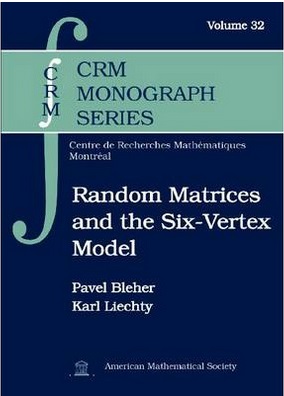
Random Matrices and the Six-Vertex Model
[BOOK DESCRIPTION]
This book provides a detailed description of the Riemann-Hilbert approach (RH approach) to the asymptotic analysis of both continuous and discrete orthogonal polynomials, and applications to random matrix models as well as to the six-vertex model. The RH approach was an important ingredient in the proofs of universality in unitary matrix models. This book gives an introduction to the unitary matrix models and discusses bulk and edge universality. The six-vertex model is an exactly solvable two-dimensional model in statistical physics, and thanks to the Izergin-Korepin formula for the model with domain wall boundary conditions, its partition function matches that of a unitary matrix model with nonpolynomial interaction. The authors introduce in this book the six-vertex model and include a proof of the Izergin-Korepin formula. Using the RH approach, they explicitly calculate the leading and subleading terms in the thermodynamic asymptotic behavior of the partition function of the six-vertex model with domain wall boundary conditions in all the three phases: disordered, ferroelectric, and antiferroelectric.
[TABLE OF CONTENTS]
Introduction vii
Chapter 1 Unitary Matrix Ensembles 1 (18)
1.1 Unitary ensemble with real analytic 1 (2)
interaction
1.2 Ensemble of eigenvalues 3 (6)
1.3 Recurrence equations and discrete 9 (4)
string equations for orthogonal
polynomials
1.4 Deformation equations for the 13 (3)
recurrence coefficients
1.5 Differential equations and Lax pair 16 (3)
for the ψ-functions
Chapter 2 The Riemann--Hilbert Problem for 19 (36)
Orthogonal Polynomials
2.1 The Cauchy transform and its 19 (1)
properties
2.2 The Riemann--Hilbert problem 20 (2)
2.3 Distribution of eigenvalues and 22 (5)
equilibrium measure
2.4 The Deift--Zhou steepest descent 27 (18)
method
2.5 Solution of the RHP for XN(Z) 45 (2)
2.6 Asymptotics of the recurrence 47 (3)
coefficients
2.7 Universality in the random matrix 50 (5)
model
Chapter 3 Discrete Orthogonal Polynomials 55 (26)
on an Infinite Lattice
3.1 The discrete log gas ensemble 55 (1)
3.2 Interpolation problem 56 (1)
3.3 Equilibrium measure 57 (4)
3.4 The g-function 61 (1)
3.5 Reduction of IP to RHP 62 (3)
3.6 First transformation of the RHP 65 (1)
3.7 Second transformation of the RHP 66 (1)
3.8 Model RHP 67 (1)
3.9 Parametrix at band-void edge points 68 (2)
3.10 Parametrix at the band-saturated 70 (4)
region end points
3.11 The third and final transformation 74 (1)
of the RHP
3.12 Asymptotics of recurrence 75 (1)
coefficients
3.13 Universality in the discrete log gas 76 (5)
ensemble
Chapter 4 Introduction to the Six-Vertex 81 (12)
Model
4.1 Definition of the model 81 (1)
4.2 Height function and reduction of 82 (2)
parameters
4.3 Mappings of the six-vertex model onto 84 (4)
other ensembles
4.4 Exact solution of the six-vertex 88 (5)
model for a finite n
Chapter 5 The Izergin--Korepin Formula 93 (16)
5.1 The Yang--Baxter equation 96 (4)
5.2 A proof of Proposition 5.1.1 100(1)
5.3 The recursion equation for Zn 101(2)
5.4 The inhomogeneous model on the free 103(2)
fermion line
5.5 The homogeneous limit 105(4)
Chapter 6 Disordered Phase 109(34)
6.1 Main results 109(4)
6.2 Rescaling of the weight 113(1)
6.3 Equilibrium measure 114(14)
6.4 Riemann -- Hilbert analysis 128(5)
6.5 Estimates on the jumps for Xn 133(2)
6.6 Evaluation of X1 135(4)
6.7 Proof of Proposition 6.1.2 139(1)
6.8 The constant term 139(4)
Chapter 7 Antiferroelectric Phase 143(54)
7.1 Introduction 143(1)
7.2 Jacobi theta functions: Definitions 144(4)
and properties
7.3 Main result: Asymptotics of the 148(1)
partition function
7.4 Equilibrium measure 149(11)
7.5 Riemann--Hilbert analysis 160(13)
7.6 Evaluation of X1 173(19)
7.7 The constant term 192(5)
Chapter 8 Ferroelectric Phase 197(12)
8.1 Introduction and formulation of the 197(1)
main results
8.2 Meixner polynomials 198(2)
8.3 Two interpolation problems 200(1)
8.4 Evaluation of the ratio hk/hkQ 201(3)
8.5 Evaluation of the constant factor 204(2)
8.6 Ground state configuration 206(3)
Chapter 9 Between the Phases 209(12)
9.1 The critical line between the 209(3)
ferroelectric and disordered phases
9.2 The critical line between the 212(2)
antiferroelectric and disordered phases
9.3 The order of the phase transitions 214(7)
Bibliography 221

 新书报道
新书报道